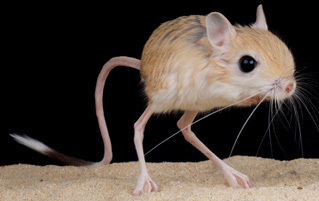6 Animals That Look Like Drunken Combinations of Other Ones

Ah, nature. Truly, she is an artist. Complex and beautiful, we are all awed by her many innovative wonders. But no artist can be "on" every single day -- not even Mother Nature. Every once in a while she wakes up hung over, calls in sick to the studio, and releases a tribute album full of mashups instead so she can get right the hell back to sleep. These are those half-assed recyclings.
Rabbit + Rat + Kangaroo = Jerboa

Jerboas might be small, but they pack some seriously potent turbo-chargers in their tiny drumsticks. These little rat-kangaroos come in short-eared, long-eared, and pygmy varieties -- though they're all blessed with long, springy hind limbs, just like wallabies and other macropods. They also look like real life Pokemon.

"Try to put me in that ball again, asshole. Try it."
Their preferred method of locomotion is the hop, yet they're unrelated to other hopping animals like kangaroos: Hopping is simply the most efficient way to get across any appreciable distance in the desert. Sand is such a malleable surface that each footstep is a battle, and therefore walking is not economically viable from a caloric point of view -- it helps that jerboas have little hairs on their feet that act like adorable snowshoes. During World War II, British soldiers in North Africa were so impressed by the crafty critters that they became the brigade's official mascot:

The Nazis were surely shaking in terror.
This type of jerboa also boasts some audacious auricles -- almost no other animal has such a large disproportion between ears and body. But this is yet another evolutionary advantage, as the large ears allow for heat to dissipate from jerboa to air, cooling it down faster than a creature of the short-eared persuasion.

Although significantly less aerodynamic.
For perspective, if a human were to have the same proportions, then Yao Ming's ears would be the size of Jada Pinkett Smith (coincidentally, this is the most interesting fact about Jada Pinkett Smith). But the pygmy jerboa variant is the most damning evidence of nature's lazy reuse of animal traits: This unassuming, tiny little creature can jump up to 9 freaking feet. Nature was so lazy, she didn't even bother changing the leap setting. She just spliced a kangaroo's stats into a mouse body, slapped a rabbit head on there, and spent the rest of the day binge-watching Buffy.
Spider + Snake = Spider-Tailed Viper
In case you can't decide whether you hate snakes or spiders more, nature has you covered. Allow us to introduce you to the spider-tailed horned viper -- a newly discovered snake and the worst four words that could ever be used consecutively.

Although now that it's been discovered, the new worst four words are "It's under your bed."
This Skyrim monster of a snake was recently discovered in the mountains of western Iran, which means that for millions of years no one has seen one and been able to report back on it, possibly due to multiphobia-induced suicide.

Although Lovecraftian insta-madness is in the running, too.
Herpetologists decided to toss some live birds in with the viper, because noble pursuits aside, some scientists are just sadistic little kids that never outgrew burning ants with a magnifying glass. They believed the snake's terror tail functioned as a lure (think anglerfish), and sure enough, the birds made their move toward the wildly gesticulating tail, mouths watering at the prospect of an easy meal:

Eye-popping terror often whets our appetites as well.
But instead of a tasty morsel, the birds ended up with a face full of fangs and lethal toxins. So if you ever find yourself trekking through Iran's mountainous regions, do try to refrain from diving face-first toward any giant spiders. It might actually be a snake.

Ha ha, just kidding. You're already dead.
Cat + Caterpillar = Chinese Bush Brown Butterfly Caterpillar
This is the caterpillar of the Chinese bush brown butterfly and totally not a piece of copyright infringement. Jesus, that is as lazy as it gets, Evolution. You can't just hot glue a kitten head onto a slug. There are rules!

Intellectual property rules, specifically.
As the name suggests, it's found throughout China, but it actually dwells across all of Asia, including Japan, where it's so goddamn cute and bizarre that it's worshiped as a minor deity. Seriously: You'll find Cat-Erpillars everywhere in pop culture, on everything from artwork to toys.

Just try to act surprised.
Sheep + Pig = Mangalitsa Pig
What is this? The product of an illicit and forbidden love at Old McDonald's Farm? We're not sure if we're looking at a beautiful pig or a sheep with a great personality. That's the Mangalitsa, a type of pig that was specifically designed to be as delicious as possible. It was bred by Hungarian nobles who tasted the glory that is bacon and thought "This will not do." So they set about breeding a tastier pig, with more lard. They ended up with a pig so delicious that its pork was reserved for Hapsburg royalty.

"We fed them a combination of fine grass, money, and poor people."
Its lard is valued by chefs all across the world because of its magical flavor-enhancing abilities. And its fur is equally valued by nasty perm enthusiasts.

Apparently you can spray activator with cloven hooves.
Snail + Moth = Sea Butterfly
Observe the majestic beauty of the flying snail:

Sex toys keep getting weirder and weirder looking ...
Wait, what? Did we take a wrong turn at the art museum and step into a Dali painting?
That's a Thecosomata, also known as a butterfly snail, which grows no larger than a single grain of sand. We are, of course, cheating a little bit. We're bastards, we know -- it's not flying through the air, but rather slicing through the water. Their "wings" are in fact extensions of a modified foot, but work just as well for flapping gracefully through the sea like an avid gardener's feverish nightmare.
The way butterfly snails eat isn't quite as graceful as their locomotion: They secrete copious amounts of mucus to create billowing, detritus-catching nets that can cover an area much larger than the snails themselves. When in danger, they can jettison the mucus, leaving a goopy minefield behind for encroaching predators to wade through. Despite their disgusting proclivities, scientists consider them important as a "canary in the coal mine," since the slightest change in oceanic acidity can dissolve them like the citizens of Toontown. But until that day, we can all rejoice in the elegant ballet that is the flapping, snot bubble-hurling sea snail.

From a distance. Once sea boogers get in your hair, they're not coming back out without a fight.
Porcupine + Grasshopper + Googly-Eyed Muppet = Spiny Devil Katydid

This perpetually startled monstrosity is called a spiny devil katydid (and in some parts, the thorny devil bush cricket), and like many of the world's most repugnant horrors, it comes from the Australia of the West: the Amazon. Much like the ordinary little katydids you've seen, it's noisy and green. Unlike the katydids of your childhood explorations, however, this one works part time as a Final Fantasy boss.

If you step on one, it drops the Gigantaxe.
Its goofy appearance does not belie a gentle, herbivorous nature. Although leaves and flowers do make up the majority of its diet, it is also frequently carnivorous and nasty. Those spike-laden forearms are quick to snatch up hapless prey, while those bolt cutter mandibles on its face make mincemeat out of anything too slow to wriggle from its grasp, including small reptiles.
We wouldn't recommend picking one of these things up, as the spines are reportedly sharp enough to rend flesh. They often emerge victorious in fights with monkeys.

Keep in mind: You're pretty much just a glorified monkey.
Kel Zhang is a writer at Cornell University and is spending his days thinking about how he can get one of those delicious sheep pigs. E. Reid Ross is a columnist at Man Cave Daily. You can also follow him on Twitter here.




